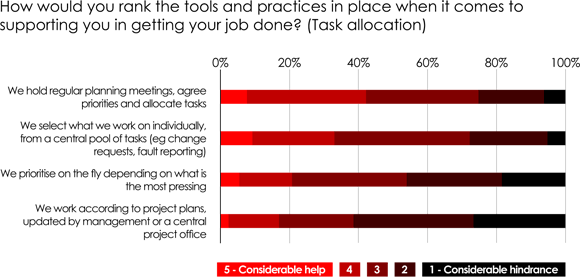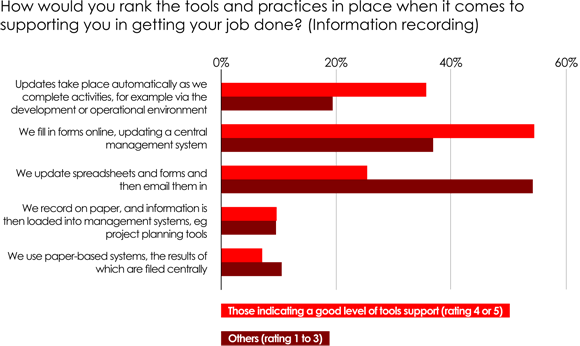This article is more than 1 year old
Making project management work
The three principles of getting the job done
Every now and then we run a poll with the Reg audience, and we know we’ve hit a nerve. On this occasion it was a simple set of questions about what tools and practices you had in place to support tasking and reporting of activities. There’s plenty of sometimes-great project management theory out there, but the tendency can be to believe that it’s only by adopting one methodology over another that can make a difference.
Thanks to the sheer volume of responses we received (1100), we’ve managed to have a good play with the data, which has revealed a number of significant correlations. If we wanted to be high-faluting we could call them ‘the three pillars of successful projects’ or some such – but how about we just tell you what they are, and demonstrate them in action? Here we go:
- Collaborative agreement of tasks between management and staff
- Reporting of, and visibility on progress in real time
- Use of business-level, rather than activity-level measures
First off, we have the collaborative agreement thing. I’ve worked in project offices, and my heart goes out to anyone who spends their days keying in actuals and reviewing baselines. But from an effectiveness perspective, an over-dependency on such approaches really does appear to be bottom of the list (Figure 1). Far more effective is a collaborative approach, where priorities and tasks can be agreed through regular meetings.

For all those who say, “well, that’s obvious,” do please note that only 23% of respondents claimed such a management style. A bit less comforting is how 51% told us they prioritized tasks on the fly – it would appear that fire fighting is alive and well in modern business.
While ‘real-time planning’ may be less than desirable however, real-time reporting does seem to have what our US colleagues would call ‘traction’. Figure 2 compares the reporting mechanisms in place for those who consider they have a good level of support, against those who are not so sure. While neither group is doing much on paper these days (phew), online and automatic mechanisms are more prevalent for the well-supported group, than for the rest.

Perhaps the conclusion about ‘real-time’ may appear to be a bit of a leap. However, the above does beg the question, why would filling in a form online make any difference to a taskee, over filling in a spreadsheet and emailing it? It makes sense that the benefit is not in the mechanism, but the outcome – that the tasking systems are updated directly, and without delay. This enables managers and staff alike to keep a much more accurate picture of the state of a project, and it is this we consider as the main benefit of online and automated systems.
But what should be reported? Truth be told, when we looked at the prevalence of different metrics, the results were pretty bland – respondents and their managers are capturing all kinds of information with gay abandon. When we looked more closely at the figures however, we started to tease out some more interesting correlations, such as the one shown in Figure 3.

Let’s work through this (they say a picture is worth a thousand words, but sometimes they can be a little reticent to speak). Taking the first row, we are looking at those who measure according to business-level criteria, and then asking whether they employ automatic updating of project information. Twice as many respondents doing such said that they felt well-supported in their jobs, compared to the others – which is a pretty significant difference. A similarly significant, yet less pronounced difference can be seen in the second row, when measurement is according to service level criteria.
Not only does this suggest that it’s good to be thinking in business terms rather than activity terms when measuring performance, but it also reinforces the second point, about real-time information capture and visibility. To be fair, automatic updating of management information is not going to be possible for everybody, indeed only a quarter of respondents had such a capability in place. But we would say to the fifty-odd percent who are using online reporting mechanisms, it’s probably worth reviewing whether you’re capturing the right information.
As for the third of respondents still mailing in spreadsheets, perhaps 2009 would be a good year to replace what you have with arguably more efficient mechanisms. And maybe give those poor data monkeys in the central project office a break, so they can get on with actually managing projects.
